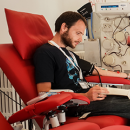All about platelet giving
Did you know that chemo can cause the platelet levels of people with cancer to drop so low that they can experience spontaneous bleeding? Administering platelets is then vital. This is how transfusions save lives every day.
-
What are platelets? They are the smallest cells in your blood. An adult has about 150 to 400 billion platelets per liter of blood.
-
Why needed. Platelets, among other things, cause blood to clot when needed. They have a very limited shelf life. So during holidays and long weekends, it's an extra challenge to keep supplies up.
-
Who can donate platelets? You must have already given blood at least once at Belgian Red Cross-Flanders. Because we need to count the number of platelets in your blood before you can become a platelet donor. Also, ideally you should have blood type O or A. Complete the donor self-test and you will know right away if you are eligible to give blood (platelets).
-
How often. You may donate platelets every 14 days. After a blood donation, you must wait at least 28 days before you may donate plasma or platelets.
- Duration: The donation process takes an average of 1.5 hours. The platelet collection itself 60 to sometimes 90 minutes.
- Where. Because we need a special device for that particular sampling, platelet donation can only be done at the Bruges, Edegem, Genk, Ghent, Leuven and Mechelen donor centers.
- How to. Here we explain step by step how it works.
- Convinced? Top. At your next blood or plasma donation, indicate that you are a candidate to donate platelets. The doctor will then check to see if your platelet level is high enough. If so, you can become a platelet donor by appointment.
Lien explains how your images are then processed and tested
Who knows, I may have indirectly helped someone with cancer with my donation!
Kenny
Donor

